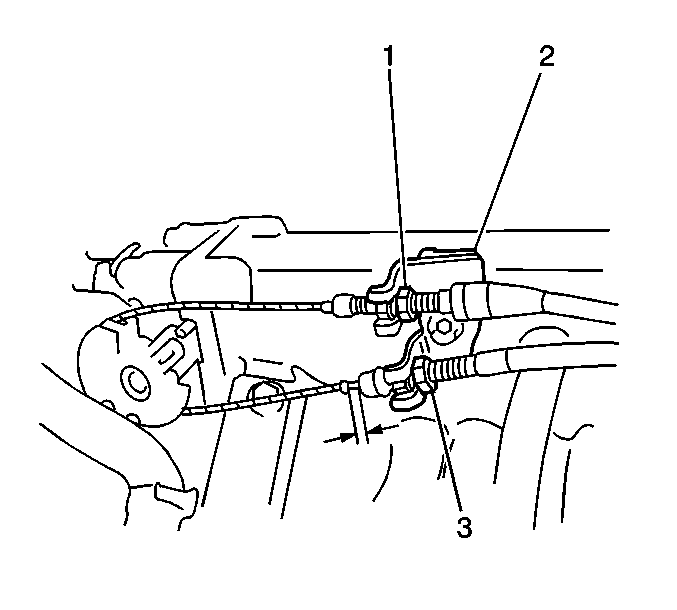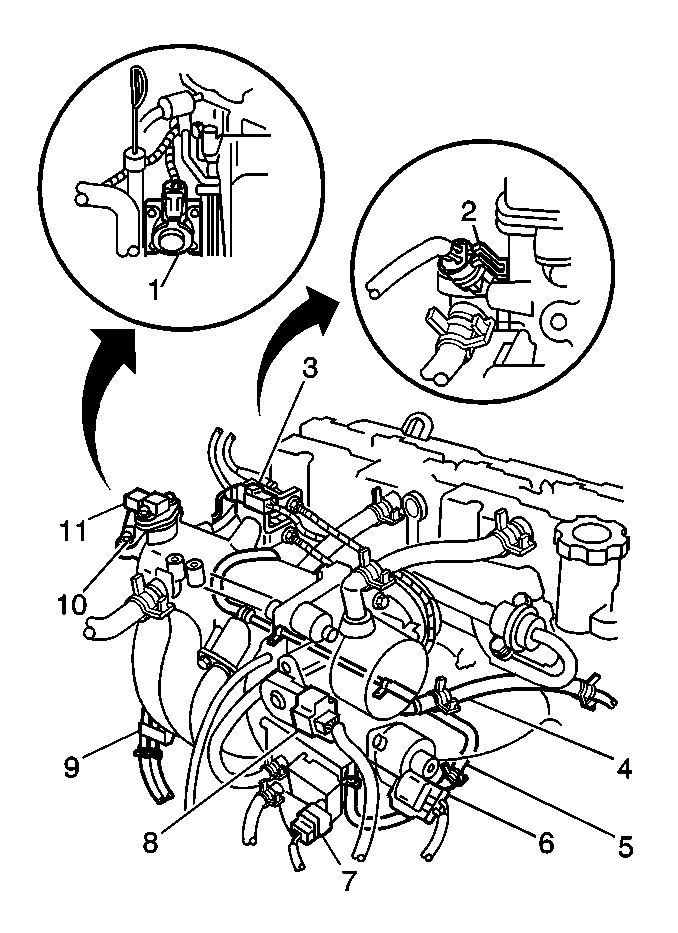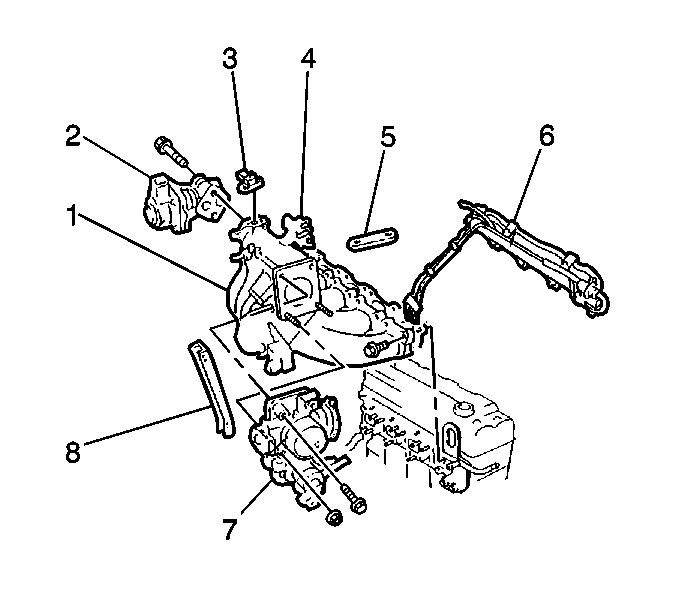Removal Procedure
- Disconnect the negative battery cable.
- Relieve the fuel pressure. Refer to Fuel Pressure Relief in Engine Controls - 2.0L.
- Drain the engine coolant. Refer to Cooling System Draining and Filling in Engine Cooling.
- Remove the air cleaner hose.
- Remove the 1 bolt and the accelerator cable bracket (2) from the intake manifold.
- Remove the cables from the throttle body bellcrank.
- Disconnect the following electrical connectors:
- Remove the bolt and the ground wires from the intake manifold (10).
- Remove the EVAP canister purge hose from the intake manifold.
- Remove the EVAP vacuum line from the intake manifold.
- Remove 1 bolt and the EVAP canister purge valve from the intake manifold and position aside.
- Remove the coolant hoses (4,5) from the throttle body and intake manifold.
- Remove the 2 bolts and the coolant line (5) from underside of the intake manifold.
- Remove the brake booster hose from the intake manifold.
- Remove the PCV hose from the intake manifold.
- Remove the breather hose from the intake manifold.
- Remove the fuel pressure regulator vacuum hose from the intake manifold.
- Remove the bolt that holds the fuel line bracket (9) to the intake manifold.
- Disconnect the wiring harness from the retaining clamps.
- Remove the banjo fitting and washer from the rear end of the fuel rail.
- Remove the 2 bolts that hold the fuel lines to the fuel rail.
- Remove the 2 bolts and the intake manifold front support bracket.
- Remove the 2 bolts and the intake manifold top support bracket.
- Remove the 9 nuts and 4 bolts from the intake manifold.
- Remove the intake manifold from the cylinder head.
- Remove the intake manifold gasket from the cylinder head.
- Inspect the intake manifold for cracks, warpage or other damage.
- Clean the gasket sealing surfaces.
- Remove the following components from the intake manifold and transfer as necessary:
Caution: Unless directed otherwise, the ignition and start switch must be in the OFF or LOCK position, and all electrical loads must be OFF before servicing any electrical component. Disconnect the negative battery cable to prevent an electrical spark should a tool or equipment come in contact with an exposed electrical terminal. Failure to follow these precautions may result in personal injury and/or damage to the vehicle or its components.


| • | The fuel injector harness (3) |
| • | The manifold absolute pressure (MAP) sensor (11) |
| • | The throttle position (TP) sensor (8) |
| • | The idle air control (IAC) valve (6) |
| • | The EVAP canister purge valve (7) |
| • | The exhaust gas recirculation (EGR) valve (1) |


| • | The Throttle Body (7) |
| • | The EGR valve (2) |
| • | The EGR pipe |
| • | The MAP sensor (3) |
Installation Procedure
- Install the following components to the intake manifold as necessary:
- Install the new intake manifold gasket to the cylinder head.
- Install the intake manifold to the cylinder head. Secure the intake manifold with the 9 nuts and the 4 bolts.
- Install the intake manifold front support bracket. Secure with the 2 bolts.
- Install the intake manifold top support bracket. Secure with the 2 bolts.
- Install the fuel line bracket (9) to the intake manifold. Secure with 1 bolt.
- Install the fuel lines to the fuel rail. Secure with the 2 bolts.
- Install the washer and the banjo fitting to the rear end of the fuel rail.
- Connect the fuel pressure regulator vacuum hose to the intake manifold.
- Install the coolant line (5) to the underside of the intake manifold. Secure with the 2 bolts.
- Connect the coolant hoses (4,5) to the throttle body and the intake manifold.
- Install the EVAP canister purge valve to the intake manifold. Secure with 1 bolt.
- Connect the canister purge hose to the intake manifold.
- Connect the EVAP vacuum line to the intake manifold.
- Connect the brake booster hose to the intake manifold.
- Connect the PCV hose to the intake manifold.
- Connect the breather hose to the intake manifold.
- Install the ground wires to the intake manifold (10). Secure with the bolt.
- Connect the following electrical connectors:
- Secure the wiring harness to the retaining clamps.
- Connect the cables to the throttle body bellcrank.
- Connect the accelerator cable bracket (2) to the intake manifold. Secure with the 1 bolt.
- Adjust the accelerator cable play to specifications if necessary. Refer to Accelerator Cable Adjustment in Engine Controls - 2.0L.
- Install the air cleaner hose.
- Fill the cooling system. Refer to Cooling System Draining and Filling in Engine Cooling.
- Upon completion of the installation, start the engine and check for fuel and engine coolant leaks.

| • | The Throttle Body (7) |
| • | The EGR valve (2) |
| • | The EGR pipe |
| • | The MAP sensor (3) |
Notice: Use the correct fastener in the correct location. Replacement fasteners must be the correct part number for that application. Fasteners requiring replacement or fasteners requiring the use of thread locking compound or sealant are identified in the service procedure. Do not use paints, lubricants, or corrosion inhibitors on fasteners or fastener joint surfaces unless specified. These coatings affect fastener torque and joint clamping force and may damage the fastener. Use the correct tightening sequence and specifications when installing fasteners in order to avoid damage to parts and systems.
Tighten
Tighten the nuts and bolts to 25 N·m (19 lb ft).


| • | The fuel injector harness (3) |
| • | The manifold absolute pressure (MAP) sensor (11) |
| • | The throttle position (TP) sensor (8) |
| • | The idle air control (IAC) valve (6) |
| • | The EVAP canister purge valve (7) |
| • | The exhaust gas recirculation (EGR) valve (1) |

